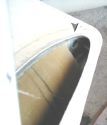
|

|

|

|
|
WIngs attached and plane precisely leveled in preparation for strake construction.
|
Wings attached in preparation for building strakes.
|
Views of the plane during construction of strakes.
|
|

|

|

|

|
|
Strake tops pre-bedded. Canard and nose portion of fuselage temporarily in place.
|
|
Top surface of nearly finished wings. They await final epoxy primer. In addition to straight leading and trailing edges, a critical component of these wings is the contour of the top and bottom surfaces. This type of construction (foam cores and spars) can leave flat spots over the spar in between the contoured foam cores which need to be filled to match. Additionally, there is a slight twist in the wings leading to a specific contour of the underside. The final finishing and contouring of these wings was performed expertly by John Michael Fleming and Jason Fleming leaving a beautiful result. John continues to perform contouring work on Velocity wings. He can be reached at his company, Final Touch Composites at 321-727-0045.
|
Bottom surface of nearly finished wings. Note lower winglet shape. These will be reshaped such that the leading edge of the lower winglet will extend to the leading edge of the wing, giving the winglets a more even sweep similar to the Wingco made wings built by Alan Shaw. This is primarily for aesthetic reasons as the aerodynamics shouldn't be significantly changed. The wingcam will be placed in the pilot side lower winglet as seen in the Wingcam section.
|

|

|

|

|
|
Smooth contours of underside of now reattached wings seen here.
|
Induction air duct carved into wing.
|
Air filter in place in wing root.
|
Oil cooler recess carved into wing root.
|

|

|

|

|
|
Guide coat applied as described above.
|
Another view of guide coat application.
|
Jason sanding away the guide coat with 100 grit.
|
What the guide coat reveals. Any pinholes or low areas will be filled.
|

|

|

|

|
|
Guide coat sanded out.
|
Another view of completed guide coat sanding.
|
Removing the Wings to allow us to flip the plane and work on the topside. Just 3 bolts, believe it or not!
|
Lifting the wings away. They are not that heavy - just a little awkward and we have to slide them a past other stuff in the hangar.
|

|

|

|

|
|
Mom and Dad relaxing next to unbolted wing. Some finish work remains.
|
We planned on reshaping the lower winglets to give (at least to me!) a more aesthetically pleasing shape. The lower winglet is not structural and is, in fact, a hollow molded part. This will make it easier to modify. Basically, the leading edge of the lower winglet will be made flush with the leading edge of the wing. Here you see the front of the winglet removed and shifted forward to the position it will ultimately be placed. Because of the installation of the winglet cam, this piece will be reshaped out of foam as shown in the following pictures. Further details on the installation of the winglet cam can be found in the "Wingcam" section.
|
Old lower winglet piece removed.
|
The opening to the wire chase conduit running along the leading edge of the wing is seen here through the section from which the lower winglet was removed (arrow). The cables for the cameras will also feed through here. The layup attaching the upper winglet to the wing itself is seen in the center of the photo.
|

|

|

|

|
|
Foam block from which new winglet bottom will be formed in place.
|
Another view of the foam block for new winglet.
|
Footpring of OLD winglet bottom.
|
Footprint of NEW winglet bottom.
|

|

|

|

|
|
Shape of fairing for the winglet cam seen on the side of the new lower winglet.
|
Wings back on to start blending surfaces into strakes. Guide coat again seen to help determine areas needing fill.
|
Right wing ready for final primer. The lower winglet still awaits reconstruction and addition of the left wingletcam.
|
Pilot side wing in final primer. Note the open wingletcam hatch.
|

|
|
Copilot side wing in final primer.
|
 Comments, questions, and suggestions are welcome! email: rich@rguerra.com
Comments, questions, and suggestions are welcome! email: rich@rguerra.com